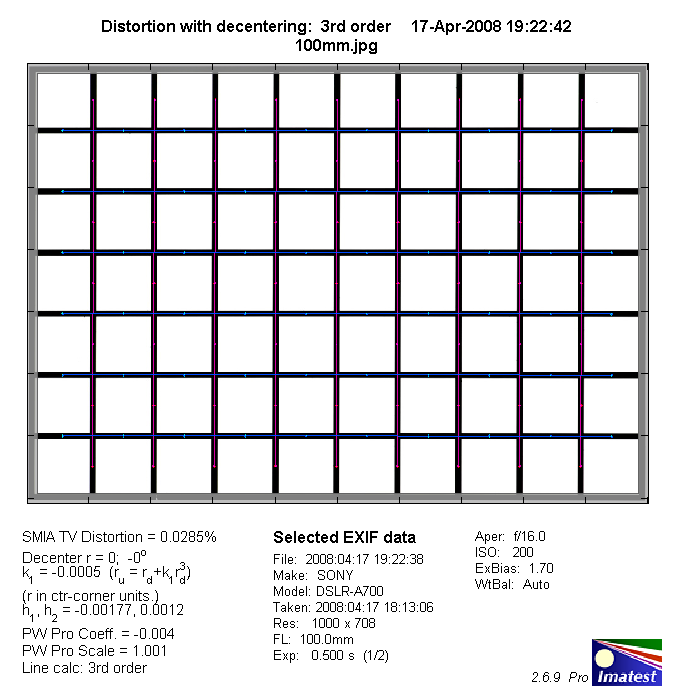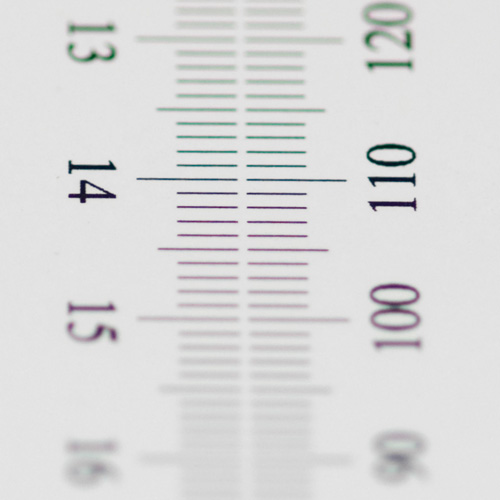|
Sony 100mm f/2.8 macro (SAL-100M28) - Review / Lab Test Report - Analysis |
|
Lens Reviews -
Sony Alpha/NEX (APS-C)
|
|
Page 2 of 2

Distortion
Typical for all macro lenses the Sony 100mm f/2.8 macro produces images which are basically
free of distortion (0.03%).

The chart above has a real-world size of about 120x80cm.
Vignetting
The Sony 100mm f/2.8 is a full format lens and as such enjoying the usual sweet spot advantage
when used on an APS-C DSLR. Within this scope the lens shows already marginal vignetting at
f/2.8 (0.3EV) and the problem is absolutely negligible from f/4 onwards.

MTF (resolution)
The Sony 100mm f/2.8 macro produced very good to excellent resolution figures in the MTF lab. At f/2.8
the quality is already on a very high level and you can squeeze out a little more when stopping
down to f/5.6, the excellent sweet spot of lens.
Typical for all lenses diffraction has stronger impact beyond f/11. The results are still perfectly
usable at f/16 but f/22 is beyond the edge. The rather low numbers @ f/22 suggest a smaller effective
aperture than indicated at this setting (probably f/27ish). In theory you can stop down to f/32
but don't expect an acceptable quality level here anymore.
Please note that the MTF results are not directly comparable across the different systems!
Below is a simplified summary of the formal findings. The chart shows line widths per picture height (LW/PH) which can be taken as a measure for sharpness.
If you want to know more about the MTF50 figures you may check out the corresponding Imatest Explanations
Chromatic Aberrations (CAs)
Lateral chromatic aberrations (color shadows at harsh contrast transitions) are very well controlled
with an average pixel width between 0.27px and 0.53px at the image borders. Generally this is nothing
to worry about in field conditions.

Bokeh
The quality of the bokeh is a primary playground for a macro lens and the Sony lens is capable of
producing very decent results here. The circular aperture shape in out-of-focus highlights remains perfectly
intact at f/2.8 and f/4. There's a bit of a one-sided outlining effect. The blur is very smooth and
uniform. However, you may also notice the rather massive amount of longitudinal chromatic aberrations
in the cards - more on this in the next chapter.

You can download the full-size images here:
Longitudinal (Axial) Chromatic Aberrations (LoCA)
LoCAs (non-coinciding focal planes of the various colors), sometimes called "bokeh CAs", can be a problem
in field conditions. As you can notice below the halos have different colors - magenta
(red + blue) in front the focus point and green beyond. The problem is rather pronounced at f/2.8 and f/4
and still visible at f/5.6. This is not overly impressive.
|
Move the mouse cursor over the f-stop marks below to observe the respective LoCAs
|
| f/2.8 |
f/4 |
f/5.6 |
|

|
Verdict
The Sony 100mm f/2.8 macro is able to produce very sharp results combined with a negligible
amount of distortions, vignetting and lateral CAs. However, longitudinal (axial) chromatic
aberrations can be quite a problem in out-focus areas (f/2.8-f/5.6) resulting in a magenta to
greenish tint in some situations - this is not unusual but unfortunate nonetheless. The build
quality of the lens is fine although it doesn't win any crown when looking towards the competition
a la Micro-Nikkor AF-S 105mm f/2.8 VR or the Canon EF 100mm f/2.8 USM macro. Same goes for the
AF speed which does still rely on the slotted drive screw rather than Sony's faster SSM (ultrasonic
AF drive). The biggest problem of the Sony 100mm f/2.8 macro is probably its price tag - at around
680€ or 580US$ it is substantially more expensive than the third-party alternatives without
offering much if anything on top.
|